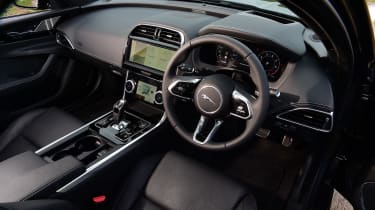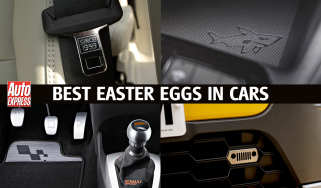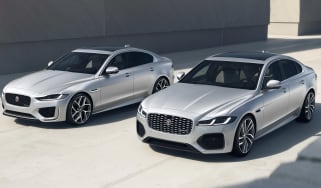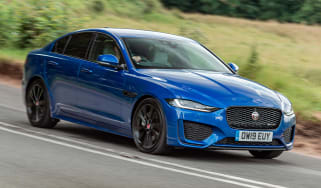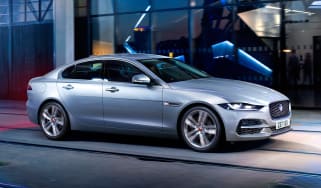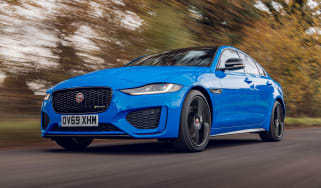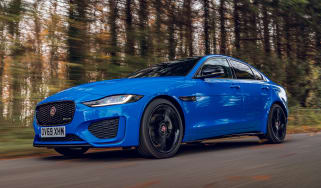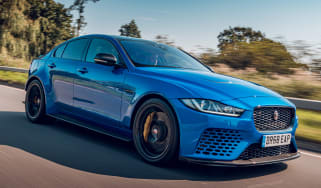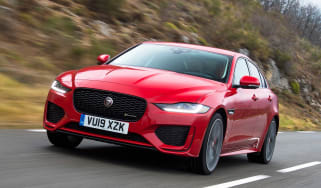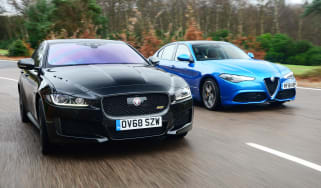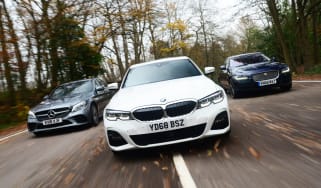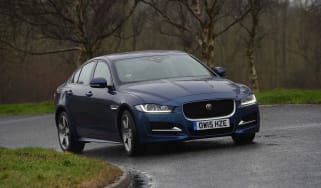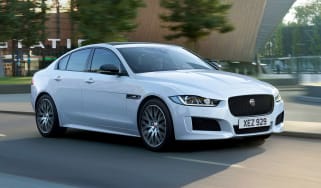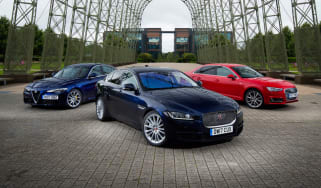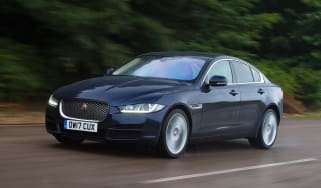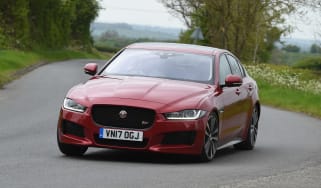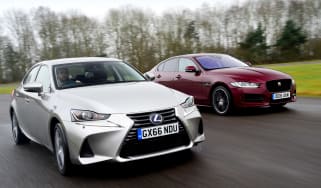Jaguar XE review
The Jaguar XE is a fab all-rounder that’s thrilling to drive and great to look at, but engine choices are now very limited

Make a list of the pros and cons of the Jaguar XE and you'll find that it just about matches its rivals in every area – especially since its 2019 update and incorporation of Jaguar’s latest Pivi Pro infotainment. However, an objective assessment can’t get across just how good Jaguar’s junior executive saloon feels. It really is a brilliant all-rounder.
It looks great, is comfortable, fun to drive when the mood takes you and has a certain X-factor that the usual German rivals – BMW 3 Series, Mercedes C-Class and Audi A4 – fail to match. It's no wonder that we named it our Compact Executive Car of the Year for three years running in 2015, 2016 and 2017.
Of course, the Jaguar’s rivals have all improved since it launched, but also got more expensive – to the point where the XE now undercuts compact executives from BMW, Mercedes and Audi by a significant margin.
The Jaguar isn’t perfect though – it can feel cramped in the back, for example – but overall the XE is a fine ownership prospect, and a marked improvement in quality over its previous iteration, the X-Type. While the line up of engines is pretty good, they’re limited to just three these days though with no plug-in hybrid offering. Jaguar has pledged to go all-electric by 2025, so we reckon you should enjoy the XE while you can.
About the Jaguar XE
The formula for the Jaguar XE is just right, and that means it's one of the best compact executive saloons for sale in the UK today. A comprehensive update for 2019 saw a useful jump forward in interior quality, on-board technology and a simplified engine and trim range – all of which have helped to keep the Jaguar competitive against its major rivals.
Used - available now

2021 Lexus
NX Hybrid
38,109 milesAutomaticPetrol2.5L
Cash £21,197
2021 Volkswagen
Tiguan AllSpace
40,093 milesAutomaticDiesel2.0L
Cash £20,997
2024 Cupra
Formentor
27,608 milesAutomaticPetrol1.5L
Cash £20,676
2023 BMW
X2
27,287 milesAutomaticPetrol1.5L
Cash £20,197In this fiercely competitive class, the Jaguar XE takes on the trio of the Audi A4, Mercedes C-Class and BMW 3 Series. A notable alternative is the Alfa Romeo Giulia – especially when it comes to driving dynamics and style.
While the Jaguar might look and feel like a competitor to those German cars mentioned above, it’s priced from around £33,000 – so the Peugeot 508 also comes into play. The compact executive segment has been hit hard by the rise of the SUV so cars like the Toyota Camry, Lexus IS, Volvo S60, Ford Mondeo and Volkswagen Passat saloon have or will soon be removed from the UK market.
The XE was an instant hit for Jaguar when it arrived in 2015, while periodical updates have helped it to maintain its position near the front of the executive car field. While rivals offer estate, coupe and hatchback variants of their standard models, the XE comes in just one body style, a four-door saloon.
The XE’s lineup is pretty simple. There are two basic models in the Jaguar XE range, R-Dynamic and Sport. The R-Dynamic is offered in S, SE Black and HSE Black.
Sadly, the raucous supercharged V6 engine found in early XE S models was removed in 2018 due to emissions regulations. There are now only three engines to choose from – two petrol and one diesel. All are four-cylinder units; the D200 diesel is mild-hybrid with rear-wheel drive, the P250 petrol is rear-wheel drive while the P300 petrol is four-wheel drive. An eight-speed automatic gearbox coupled with all the engines.
Whichever model you choose, the XE delivers an engaging driving experience. We’d even go as far as suggesting you wouldn’t have any more fun behind the wheel of a BMW 3 Series. The XE’s most prominent dynamic attribute is its fast, sharp steering and an agile feel. In addition, the XE is pretty comfortable for cruising. The suspension is designed to work with larger wheels, so the ride isn't too choppy if you pick larger rims, however the models with smaller wheels are positively luxurious.
A recent price cut means the XE starts at just over £33,000, while the P300 Sport weighs in at just over £43,000.
Engines, performance and drive
The XE ushered in a new era for Jaguar. The firm has plenty of history with aluminium construction, but the baby saloon was the first car based on Jag’s iQ[Al] platform – also known as the D7a.
This features double-wishbone front suspension and a multi-link rear axle, which gives the XE its trademark balance and agility. With Jaguar’s Drive Control system you can tailor the throttle response, gearshift strategy and steering set-up to suit your preference, just like you can in its rivals, but Jag's Adaptive Dynamics suspension system is an option.
Behind the wheel, the overriding characteristic of the Jaguar XE is the way it feels dynamic yet comfortable at the same time. The sophisticated multi-link rear suspension set-up smothers the bumps while keeping the wheels firmly in contact with the road, so there’s lots of feel. Point the XE’s nose through a series of corners, and you’ll receive plenty of confidence-inspiring feedback whether you choose the rear-wheel drive or all-wheel drive set up.
The Jag’s steering is precise and there’s plenty of grip too. Dynamic mode alters the steering weighting, throttle response and the auto’s shift pattern, plus it turns the dials red. As you’d expect, the XE is a refined and comfortable cruiser, with the Sport suspension quickly losing its low-speed stiffness and soaking up bumps and undulations well. The brakes are worth a mention too as you’re able to lean on them hard with decent pedal feel.
The rear-wheel-drive chassis always seems firmly planted but there’s a definite sense of the car being pushed from the back and steered from the front – great balance, in other words. It makes the XE feel that bit more special when you up the pace.
XE models equipped with four-wheel drive feel sure-footed, helping to build confidence in adverse conditions. It also still feels like the onus is on powering the rear axle. For most buyers in the UK though, the reduced economy means it isn't necessary – the standard car doesn't exactly lack grip, and a good set of winter tyres will do a similar job.
Either way, the XE’s dynamic prowess becomes more significant the further up the core engine range you go, with the most powerful P300 model veering into high-performance territory.
With a light 2.0-litre petrol engine mounted in the nose, the XE’s front end feels as keen to change direction as any example we’ve driven. The steering is fairly weighty, but has plenty of precision. It’s quick enough to match the rate of response from the chassis, while there’s a decent level of grip.
Although the Jaguar rolls a little in corners, this compliant side to the car’s set-up means that away from the test track and on the road, the XE offers a ride quality that rivals like the Alfa Giulia and Audi A4 can't match.
The standard-fit eight-speed automatic is very good indeed, with smooth shifts in full auto mode. The changes are fairly quick in manual mode, but not quite as immediate as you’d ideally want, although the metal steering wheel paddles are a joy to use. It’s not quite as effective as a BMW gearbox, but it’s more responsive than the Alfa’s similar eight-speed transmission. The convenience enhances the XE’s relaxing properties, yet the auto is snappy enough to suit a more aggressive driving style.
All XE models ride with smoothness and refinement, helped in part by it being on the lighter end of the compact executive spectrum at 1,651kg. Whether you pick the 18-inch standard wheels (19-inch for the HSE trim) or 20-inch optional items, the XE is best described as firm but forgiving, and feels exactly how you’d want a small sporting Jaguar saloon to feel.
The electric power steering is quick to react and offers plenty of feel when away from the slightly numb straight ahead position. Throttle response is good, too, especially if you sharpen things up with the Configurable Dynamics system that allows the driver to select sharper throttle reactions and firmer suspension settings.
Engines
The Jaguar XE range was simplified in 2019 to include just three engines – one diesel and two petrols. The former, badged D180, is a 2.0-litre turbocharged four-cylinder with 178bhp and a choice of rear-wheel drive or four-wheel drive layouts. Another shake-up in 2021 saw the line-up reduced to just two engines - the D200 mild-hybrid diesel and the P300 petrol. A P250 petrol engine was added in 2021 with 247bhp.
The P300 boasts 296bhp; has four-wheel drive, and like all Jaguar XE models comes with a standard eight-speed automatic gearbox. It’s the fastest model in the range, with a 0-62mph time of just 5.7 seconds and a limited top speed of 155mph. If you’re looking at a nearly new car, the slightly less powerful P250 manages the same sprint in 6.5 seconds with the same top speed. The latest D200 diesel engine with mild-hybrid tech manages a 6.9-second 0-62mph time, whereas the formerly available D180 takes 8.4 seconds to complete the same sprint.
When compared directly to equivalent BMW 3 Series models, the XE trails slightly in performance terms – but not by a huge amount.
MPG, CO2 and running costs
All Jaguar XE models are powered by 2.0-litre engines that have been developed with one eye on economy and efficiency. Naturally, the most efficient engine in the range is the D200 diesel, and Jaguar claims an impressive best of 58.1mpg for combined economy, with CO2 emissions of 127g/km. Beware choosing the correct specification though, the same powertrain in the SE Black return 54.4mpg and 136g/km. That’s still a lot better than the previously available D180, whose figures sit at 46-50.7mpg for the rear-drive version and 41.6-46.4mpg for the four-wheel drive model. CO2 emissions were 146g/km and 161g/km, respectively.
The powerful P300 is the thirstiest XE with a combined fuel economy figure of 31.6mpg. CO2 emissions are quoted at 204g/km, but will vary depending on wheel size.
The XE compares favourably with most of its closest rivals, but the ever-dominant BMW 3 Series still offers a better balance between running costs and performance.
It’s worth noting that should you regularly tap into the XE’s excellent driving dynamics, you’ll see the above mpg figures drop quite drastically.
Insurance groups
The Jaguar XE starts at insurance group 27 in D180 guise and climbs to group 33 for the top-spec P300. For comparison, the BMW 3 Series sits in groups 24 to 40, depending on which specification you choose.
Every XE comes with remote central locking, an alarm and an engine immobiliser, as you’d expect, but the cost of parts and labour for accident repairs means insurance costs are suitably premium.
Depreciation
The Jaguar badge seemingly does wonders for its depreciation, or lack of it. Our experts predict that the latest Jaguar XE will hold on to around 54 per cent of its value after three years and 36,000 miles. The industry-standard BMW 3 Series only manages 50 per cent in comparison with the Mercedes C-Class and Audi A4 at 48 per cent and 46 per cent respectively. The Alfa Romeo Giulia is at a lowly 45 per cent.
To get an accurate valuation on a specific model check out our free car valuation tool...
Interior, design and technology
Jaguar facelifted its XE in 2019 to keep pace with the latest Audi A4, BMW 3 Series and Mercedes C-Class – all of which combine modern styling with plush, high-tech interiors. Thankfully the handsome exterior was only subtly tweaked with the arrival of a sharper front end and re-styled bumpers but the biggest changes came inside, where the XE benefits from big steps forward in quality, design and infotainment.
It’s not exactly spacious in the XE, but there are certainly worse cabins to spend your time in. The facelift introduced a new steering wheel, an F-Type-style gearlever and a range of high-quality plastics and decorative trim pieces have helped to lift what was an ageing interior.
Even entry-level S models get ambient interior lighting, dual-zone climate control, an auto-dimming rear-view mirror, 12-way electrically-adjustable front seats, a leather-trimmed steering wheel and a 10-inch touchscreen infotainment system. Leather upholstery is standard.
Step up through the XE’s trim levels and even more equipment gets lumped in. Improved leather, online connectivity, plus a wealth of driver assistance and safety kit. There’s a hefty options list too – it’s possible to spend a huge amount of money on items such as memory-function heated and cooled seats, a remote heating system or a premium Meridian audio set-up.
Overall, the level of quality, fit and finish matches that of a BMW 3 Series or Mercedes C-Class and the XE’s design and interior certainly feels worthy of its price.
Those after the most ostentatious XE are pointed towards the supercharged V8 XE SV Project 8, with its huge bumpers and massive rear wing. They all sold out pretty quickly, given their extensive performance appeal – despite the price tag of £150,000.
Sat-nav, stereo and infotainment
The most important addition to the XE’s specification following its 2019 refresh was the adoption of uprated infotainment with Apple CarPlay and Android Auto connectivity. All models get the latest Pivi Pro system – which looks elegant but is easy to use. This comprises a 10.2-inch touchscreen mounted on the dashboard, with a second touchscreen lower on the centre console: the former is used to control functions like media and sat-nav, while the latter allows easy access to car settings like climate control, heated seats and drive modes.
The system works well – especially the lower screen and its sensible collation of key functions, along with physical rotary dials whose function changes according to which sub-menu is selected. Pivi Pro is well-presented and is easy to use once you’ve become used to its unique design. Other systems are a little snappier and once you’ve got your head around it; Mercedes’ MBUX system is more impressive.
Practicality, comfort and boot space
Packaging is one of the XE’s flaws, as it feels a little cramped in the rear, particularly next to the Audi A4. There’s still more than enough space for four adults to sit in perfect comfort, however. A sliding panoramic roof is an optional extra on all XEs but it’s one that’s worth ticking to give the cabin a more spacious feel.
It’s slightly shorter and wider than a BMW 3 Series, but the Jaguar is no bigger inside, and it trails the Alfa Romeo Giulia in terms of rear seat space.
The XE gets comfort spot-on when it comes to ride quality, though. Regardless of wheel and tyre choice, it levels out most road surfaces in the spirit of a more expensive, more luxurious car. This is one of its most alluring qualities.
The driving position is pretty spot-on too, with plenty of adjustment – the wheel comes back some distance, and the chair is set low, again giving the XE the feel of a coupe. Taller drivers might find the roof lining a little too close for comfort, but it should accommodate all but the very tallest.
There is a decent amount of storage in the cabin, with good-sized door pockets and nets for rear passengers. The central storage bin is sizeable too, as is the glove compartment.
Dimensions and size
The XE of course conforms to the conventional ‘three-box’ shape of the executive saloon segment, but it’s actually a little shorter and wider than the BMW 3 Series, while also being lower. The last of those properties explains the very slight headroom deficiency, and the coupe-like profile, although Jaguar could have perhaps squeezed a little more legroom and boot space from the cabin.
In terms of manoeuvrability the XE is fine, because despite the low seating position it’s easy to judge the corners thanks to its short overhangs and decent visibility.
Leg room, head room & passenger space
The XE is generally a lot more fun when you’re sitting up front. That wide centre console hides a thick transmission tunnel, which is most obvious in the back. It’ll make things uncomfortable for a third rear passenger in the middle, and amplifies the XE’s main problem – cramped rear seats.
You’d expect a car of this length (and in this class) to have more space behind the front seats. Anyone over six-foot might find their fancy haircut being flattened by the XE’s roof lining.
The doors open nice and wide at the front and back, making getting in and out easy, but that transmission tunnel means anyone sitting in the middle rear seat will have their knees apart and feet fighting for space with those of passengers sitting in the outer chairs.
Boot space
The XE’s boot is a bit of a letdown – it’s a little awkwardly shaped with a narrow opening and measures in at 410 litres, which is down significantly on the Alfa Giulia, BMW 3 Series and Mercedes C-Class.
Reliability and safety
The latest Jaguar XE did not feature in our 2023 Driver Power survey, but the British manufacturer itself achieved an encouraging 10th-place finish out of 32 manufacturers, beating Mercedes, BMW and Audi. Owners reported that their cars were amazing to drive but heavy on fuel, while overall reliability was not as good as some rivals.
On the safety front there’s no need to worry, with the car achieving an excellent five-star result in its Euro NCAP crash test in 2015. Its 92% score for adult occupant protection was particularly impressive. Standard safety kit includes six airbags, traction control, stability control, Automatic Emergency Braking (AEB), Lane Keep Assist, Traffic Sign Recognition and Pedestrian Contact Sensing.
Warranty
The Jaguar XE comes with a three-year, unlimited mileage warranty, meaning business buyers looking to do big mileages can have peace of mind. It’s fairly standard aside from the mileage de-restriction, covering any mechanical or electrical parts that fail outside of what could be considered normal wear and tear.
Servicing
Jaguar offers fixed price service plans with flexible payment options. Plans are also transferable between cars, so your plan can be carried across to any subsequent Jaguar model. All parts used in Jaguar’s servicing are covered by a 24-month warranty.

